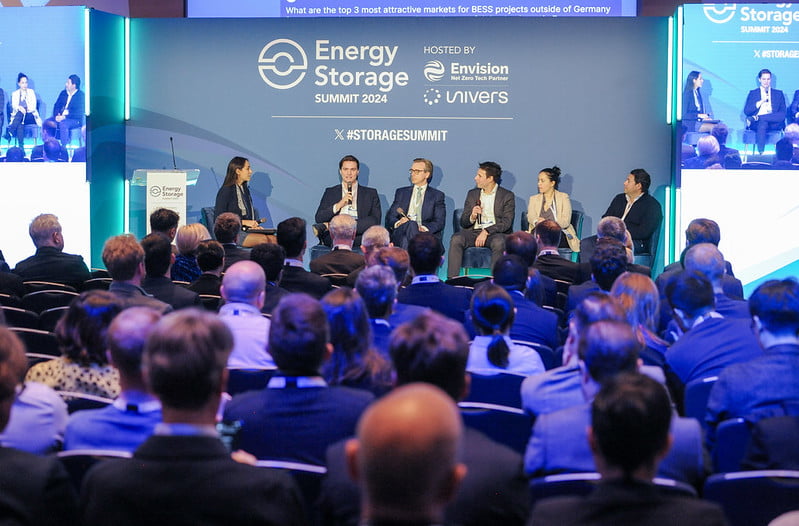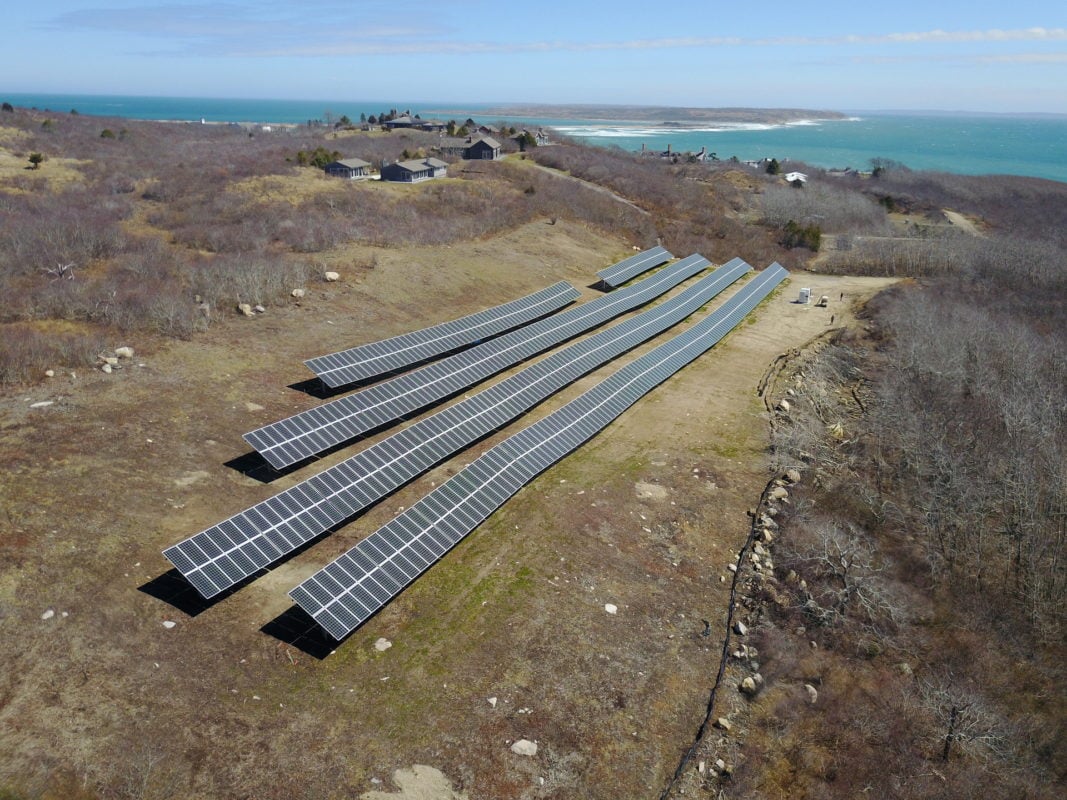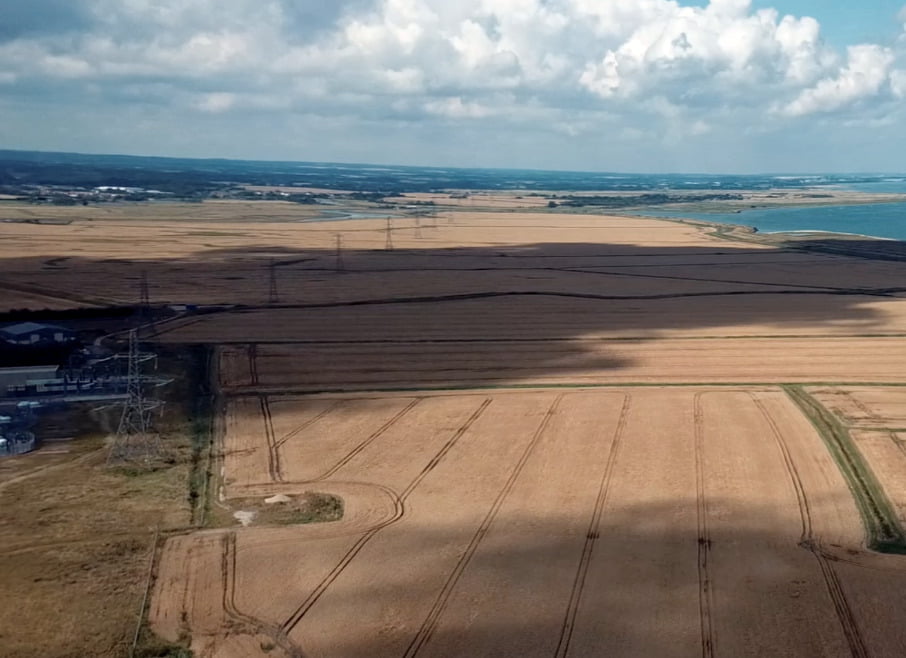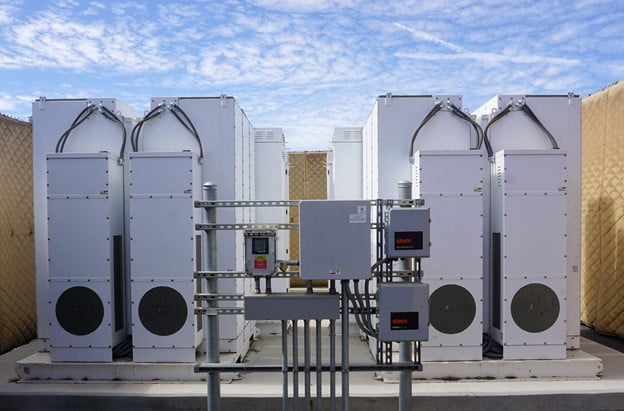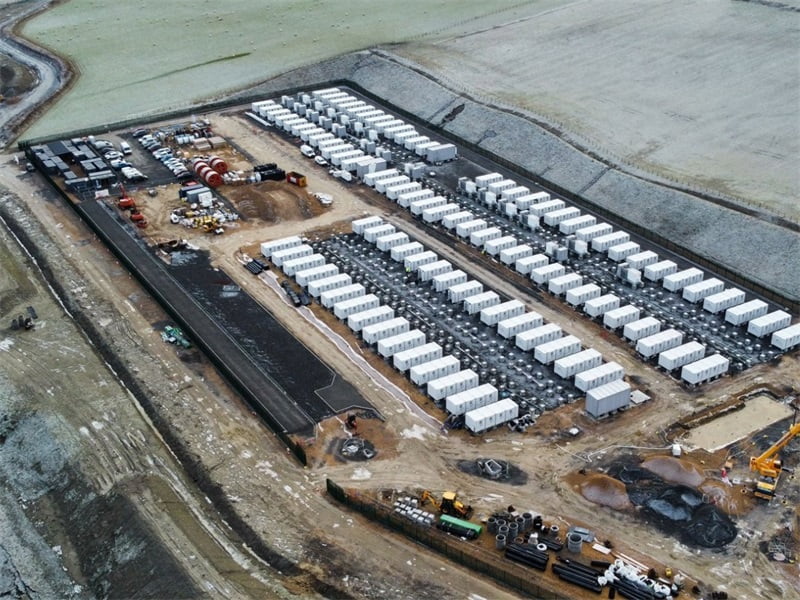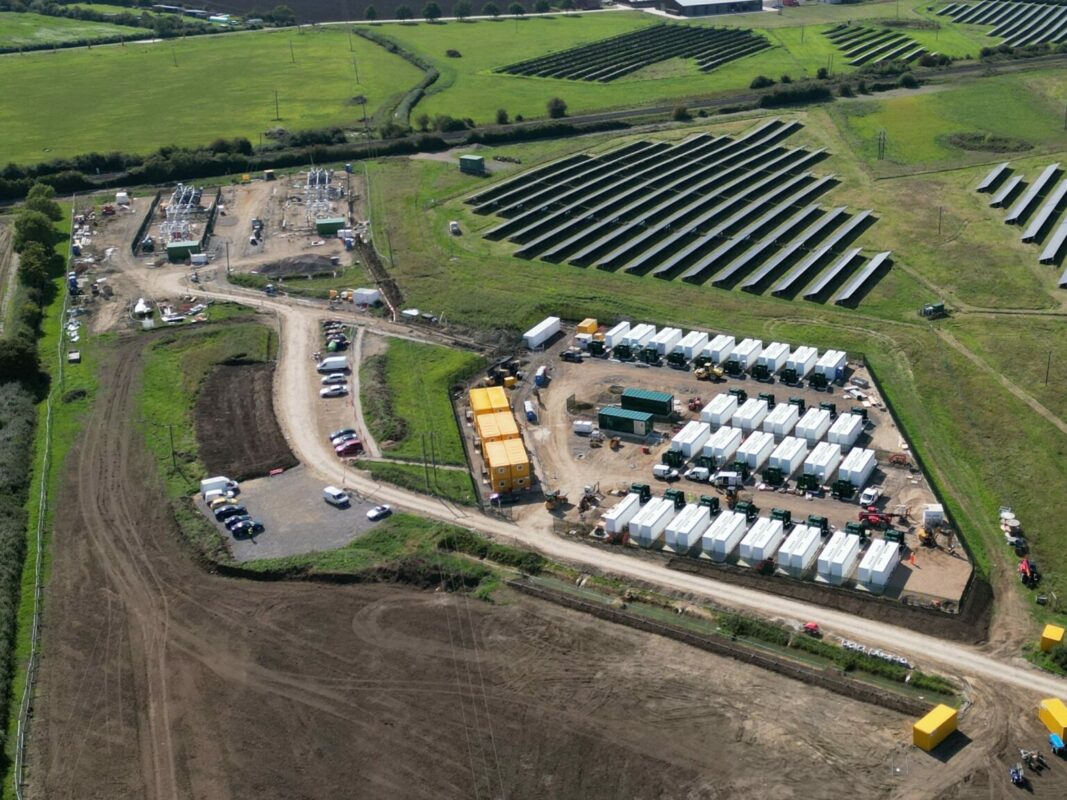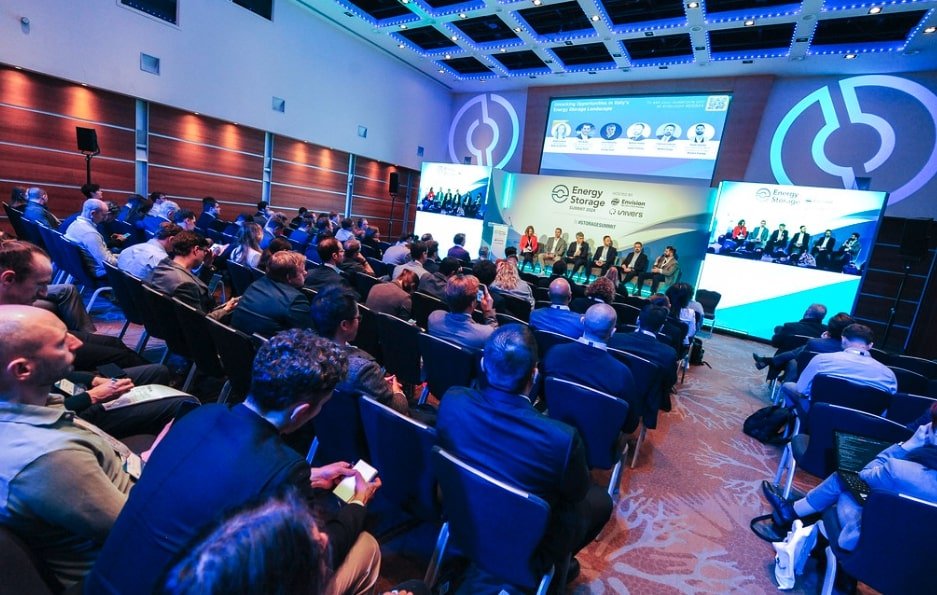The BESS is being developed by independent power producer (IPP) Clearway Energy, as per the BLM National NEPA Register. The Register said it would generate 150MW of power and “store up to 1,200MW” of electricity. Energy-Storage.news has asked the BLM to clarify the latter figure, which we would assume should be MWh/megawatt-hours, and will update this article if and when a response is received.
The BESS will utilise lithium-ion batteries and occupy 20 acres of land, with 23 used in total for the balance of plant (BOP) components. An expected commercial operation date (COD) has not been revealed.
Although unconfirmed by the BLM and Clearway, Alta 1 Wind appears to be part of the larger Alta Wind project that Clearway acquired from developer Terra-Gen a decade ago. It was then said to be 947MW in power, although recent announcements indicate it could be larger.
The BESS would smooth out the wind plant’s generation by discharging to the grid when the plant’s production tails off.
California has the most BESS deployments in the US, driven by its high solar PV deployments and long-term power purchase agreements (PPAs) between utilities and project owners (through grid operator CAISO’s Resource Adequacy framework), enabling financing for large-scale projects.
Clearway is set to commission a separate BESS project totalling 147MW/588MWh also in Kern County this year and is also highly active in Hawaii, where it has multiple large-scale solar-plus-storage projects online.
Energy-Storage.news’ publisher Solar Media will host the 5th Energy Storage Summit USA, 19-20 March 2024, in Austin, Texas. Featuring a packed programme of panels, presentations and fireside chats from industry leaders focusing on accelerating the market for energy storage across the country. For more information, go to the website.
UK’s Harmony Energy has ready-to-build pipeline in France, Germany and Poland
Like the other UK BESS fund managers – Gresham House and Gore Street Capital – Harmony Energy is going into new markets as UK revenues tumble.
“We’re moving in a big way into the French market but also looking at Germany and Poland. France, Germany and Poland are our next big moves though there are opportunities elsewhere we are exploring,” said Paul Mason, Harmony chief investment officer, at the ‘Highlighting the Investors’ Current Appetite for Energy Storage’ panel on Day 1 of the two-day event.
“We’re now in a place where we’ve got a really good pipeline that’s ready-to-build in all those places.”
As reported by Energy-Storage.news last year, Harmony Energy Poland was aiming to bid for 500MW of BESS projects into Poland’s capacity market auction at the end of 2023. Developer and independent power producer (IPP) Greenvolt won most of the awards that went to BESS in the auction.
Talking about Harmony’s approach to investing in new countries, Mason added: “It’s important to have local contacts on the ground that understand development, and on top of that we can layer on processes, systems and a way around developing BESS specifically.”
Enel sells 49% stake in Italy BESS projects to Sosteneo for €1.1 billion
The transacted vehicle will see through the construction, ownership and operation of a portfolio comprising 23 battery energy storage system (BESS) projects as well as three renovations of open cycle gas turbine (OCGT) plants totalling 0.9GW.
The deal is part of Enel’s partnership business model outlined in its business plan for 2024-26. Enel has been a first-mover in the BESS market in Italy, winning the vast majority of the BESS project awards in early 2022’s capacity market auction, on which it started construction last year for 2024 delivery.
The deal still needs to be cleared by Italy’s competition regulator and Italy’s council of ministers, and is expected to close in the first half of 2024. The ultimate price paid by Sosteneo will depend on “an adjustment mechanism customary for these kinds of transactions,” Enel said.
Italy is one of the most eagerly-anticipated markets in Europe, with gigawatts of deployments expected over the coming few years. The challenges and opportunities, including an EU-funded capacity market auction specifically for energy storage (called MACSE), were discussed in detail on a panel at last month’s Energy Storage Summit EU 2024 in London (Premium access).
Outside of Italy, Enel is also very active in the energy storage markets in the USA and Chile, recently bringing online 555MWh of projects and starting construction on a co-located 67MW project in each market (respectively).
One of its BESS projects also won in a recent auction run by Greece (similar to Italy’s) while last year it proposed several large-scale BESS projects in Spain as well, one 60MWh and one 38MWh, both co-located with solar.
Sosteneo for its part owns one of the largest BESS projects by MW power in Europe, the 100MW/100MWh transmission-connected Richborough BESS in the UK, which came online in late 2023.
US DOE allocates US$366 million to 17 projects in Energy Improvements in Rural or Remote Areas programme
At least 12 projects will support tribal communities, installing solar and BESS to provide electricity for 300 homes. Among these projects, the Solar + Storage Microgrids for Rural Community Health Centers project plans to provide solar PV systems, BESS and microgrids in community health centres to decrease power outages and ensure electricity for critical life-saving equipment.
Meanwhile, the Hopi Nation Community Solar Project will use hybrid microgrids, solar PV systems, and BESS to power critical community services, IT, waste management and health and human services.
DOE said rural and remote communities usually face multiple energy challenges due to their smaller populations and isolation from larger electrical systems, including higher electric bills, unreliable energy supplies and no access to electricity.
In total, more than 17 projects across 20 states and 30 Tribal Nations and communities were included in this announcement. The announced projects are part of DOE’s Energy Improvements in Rural or Remote Areas (ERA) programme, which improves the reliability and affordability of energy systems in communities across the country with 10,000 or fewer people.
Prior to these projects, DOE also chose three companies, including Sunrun, Sunnova and power product supplier Generac, to install rooftop solar and battery storage systems for vulnerable households in Puerto Rico.
The selection was the first round from the 2023 PR-ERF Funding Opportunity Announcement. Eligible beneficiaries will include very low-income, single-family households that are either located in areas that have a high percentage of very low-income households and experience frequent and prolonged power outages or include a resident with an energy-dependent disability.
This story first appeared on PV Tech.
Energy-Storage.news’ publisher Solar Media will host the 6th Energy Storage Summit USA, 19-20 March 2024 in Austin, Texas. Featuring a packed programme of panels, presentations and fireside chats from industry leaders focusing on accelerating the market for energy storage across the country. For more information, go to the website.
UK: 150MW Cleve Hill BESS project rejected by local authority
According to an article carried by national broadcaster BBC, residents feared using lithium iron phosphate (LFP) battery cells to store energy. This led to a protest outside the council’s office before the planning committee meeting on Wednesday (28 February).
Past coverage by our colleagues at Solar Power Portal on the project, which was renamed Project Fortress, indicated that the battery storage element of the project would include an installed capacity of 150MW, making it amongst the largest in the country.
The report from the Council claimed that LFP batteries are “more subject to explosion risk than other types” and that committee members rejected the battery safety management plan for the site “after nearly four hours of debate”.
The primary cause for the rejection of the safety management plan was due to a “lack of water storage facilities on site, a lack of access to the battery storage area, and the lack of an evacuation plan”.
It is worth noting that the Cleve Hill project went into construction in April 2023, and investor Quinbrook Infrastructure Partners has described the facility as the UK’s “largest solar and battery energy storage project”.
See the full original version of this article on Solar Power Portal.
Stem: Full-year positive EBITDA in 2024 to follow Q4’s ‘milestone achievement’
California-headquartered Stem was one of the early entrants to the behind-the-meter (BTM) commercial and industrial (C&I) energy storage market, using its Athena software platform to help customers peak shave and reduce their electricity bills, while also leveraging the software’s AI capabilities to use those battery systems to provide grid services through utility programmes.
From there, the company has diversified to add front-of-the-meter (FTM) projects to its portfolio, predominantly smaller grid-scale solar-plus-storage projects in key markets like Massachusetts that have programmes in place to incentivise market participation of co-located resources.
It has also added solar PV asset monitoring and controls to its suite of services through the 2022 acquisition of Also Energy, again focused on the C&I market segment.
34% CAGR forecasted for revenues
The company noted that it met its previous commitment of achieving positive adjusted EBITDA in the second half of 2023. CFO Bill Bush referred to this as a “milestone achievement” for the business, which Stem said it would be on track to do in its Q3 earnings call.
Its fourth quarter performance was stronger than in the equivalent period of last year despite delays in getting grid interconnections and in permitting, as well as “slower than expected deliveries from hardware suppliers,” which impacted the storage business negatively, CFO Bill Bush said.
Having narrowed its full-year loss from US$46 million in 2022 to US$20 million, it now expects to stay on positive EBITDA for 2024 on an adjusted basis, guiding for between US$5 million to US$20 million. This achievement of adjusted positive EBITDA for the year was another commitment the company made in 2023.
Revenue is being guided to within US$600 million to US$700 million for the year, representing a CAGR from 2022 of 34% while compound annual rate of returns (CARR) is expected to rise to between US$115 million and US$130 million. From US$65 million CARR in 2022 and US$91 million last year, that would represent a 37% CAGR.
Inflection point
Stem claimed 2024 will be an “inflection point for profitable growth,” in which the company no longer expects to need to issue equity to fund operations.
The company claimed that factors including product and service differentiation in the various markets it is active in, as well as ongoing efforts to reduce costs, would contribute to this year’s expected profitability.
For instance, the company claimed that its battery assets in Texas’ ERCOT market theoretically outperformed others. Stem did a back-casted simulation of how its Athena software performed versus competitor softwares, and claimed it earned 28% higher revenues on average, publishing its findings in a white paper in December.
According to Stem CEO John Carrington in prepared remarks, there are two main reasons for this “outperformance”: being “highly accurate price forecasting” and “advanced optimisation”.
Stem’s spread across different market geographies means it has a “data advantage” over rivals, allowing it to forecast how volatility will play out in ERCOT’s energy-only market, rather than relying on historical pricing data.
The AI-driven Athena software meanwhile can co-optimise continuously across all market products that have changing values over time, Carrington said, with that aforementioned data advantage also coming into play to consistently improve Athena’s algorithms.
In terms of costs, recent hardware cost declines have helped drive “better economics for our customers,” Carrington said.
The hardware situation will be further improved, the company believes, by “favourable conditions in the supply chain,” Carrington said, including the potential entrance of battery cell manufacturers into the market to offer integrated energy storage hardware solutions, driving competition in the space.
On the software side, Stem has also established operations in India, including a Center for Excellence, which is a shift to a lower cost geography that the company nonetheless sees as a strong one for software development. It also wants to parlay its strengths in software into a bigger source of recurring income.
As well as federal incentives from the Inflation Reduction Act (IRA) that have put the already-expanding US market onto an even more rapid growth trajectory, state-level policy, particularly storage procurement mandates “targeting multiple gigawatt-hours” in states including Maryland, Michigan and New Mexico help the underlying economics of Stem’s core business, the CEO said.
Stem’s contracted backlog stood at US$1.9 billion as of the end of 2023, a 99% increase from US$969 million at the end of 2022. An analyst on the call to explain results asked for some clarity what sort of backlog conversion cycle times could be expected.
The company expects between US$1.5 billion to US$2 billion in bookings in 2024. CEO Carrington noted that Stem expects to add several large deals to its order book soon. CFO Bush added however that those projects for the most part represent increased size, complexity and duration of storage asset.
The backlog therefore getting longer will have some impact on the revenue guided, Bush said by way of reply to the analyst’s question.
Energy-Storage.news’ publisher Solar Media will host the 6th Energy Storage Summit USA, 19-20 March 2024 in Austin, Texas. Featuring a packed programme of panels, presentations and fireside chats from industry leaders focusing on accelerating the market for energy storage across the country. For more information, go to the website.
Energy Vault China gravity ESS project connected to grid; starts building three others
Energy Vault didn’t say when the project will be fully operational, but it will provide more updates on it when the company releases its full-year results on 12 March.
Energy Vault added that its local partners – environmental services and waste management firm China Tianying (CNTY) and developer Atlas Renewable – now have nine other EVx projects underway in China totalling 3.7GWh, of which three have started construction, all 4-hour systems.
They are:
a 17MW/68MWh project in Zhangye City, Gansu Province, being built adjacent to a renewable energy plant and a national grid interconnection site (pictured above)
a 50MW/200MWh project in Ziuquan City, Jinta County, Gansu Province
a 25MW/100MWh project in in Huailai Cunrui Town, Zhangjiakou County, Hebei Province
The Rudong and Zhangye projects have been designated “new energy storage pilot demonstration projects” by China’s National Energy Administration (NEA).
The Rudong project will charge from a nearby wind farm and discharge to the grid while its energy storage medium – composite blocks – will also provide an outlet for CNTY to utilise waste materials like concrete debris and coal ash as part of its waste remediation business.
Energy Vault CEO Rob Piconi discussed the firm’s gravity-based technology – which many are sceptical about – as well as its battery energy storage system (BESS) and green hydrogen projects in a Premium interview article last year.
Energy-Storage.news’ publisher Solar Media will host the 2nd Energy Storage Summit Asia, 9-10 July 2024 in Singapore. The event will help give clarity on this nascent, yet quickly growing market, bringing together a community of credible independent generators, policymakers, banks, funds, off-takers and technology providers. For more information, go to the website.
Friday Briefing: Advanced inverters, fire safety, and a head start on long-duration investment
Last week’s most-read story on the site was indeed our Energy-Storage.news Premium coverage of a 300MW/600MWh lithium-ion battery energy storage system (BESS) project in Scotland, UK, which will use advanced inverters to provide system stability services to the grid.
Chief among those services is inertia, and that’s enabled by the advanced inverters, supplied by SMA and integrated into the design by Wartsila Energy Storage & Optimisation, the BESS supplier and integrator.
This morning I spoke with Semih Oztreves, director of global infrastructure at Zenobe Energy about the project. While our interview was largely from a technical perspective, one thing that Oztreves very neatly explained is why this application of advanced inverters could be an important one:
While it’s “an exciting technology and a big leap in terms of the services batteries can provide,” Oztreves said, “the value of the service doesn’t account for a significant amount of revenues that battery storage assets can earn.
“However, from an industry standpoint, and from the government and regulation perspectives, it is, in my opinion, a major discovery because you can offset emissions from generation significantly by buying inertia from grid-forming clean technology. It’s millions and millions of tonnes of CO2 you could save by doing this; it’s a very quick win. It’s [also] a lot cheaper,” Oztreves said.
“However, from Zenobe’s perspective, and for government and the public, this technology represents a significant milestone. We can now significantly offset emissions from generation by purchasing inertia from grid-forming inverter technology. For the UK, that means preventing millions of tonnes of CO2 emissions with a solution that can be deployed at speed and at a highly competitive cost compared to the traditional alternatives like thermal generation that have been historically relied on to deliver these inertia services. This is what matters for policymakers and for the electricity system operator (National Grid ESO).”
It’s not just one for the UK grid either. For example, yesterday we reported that work is about to begin on a project in Victoria, Australia, which will be delivered by Fluence, again with SMA advanced inverters, that is among eight to receive funding support from the Australian Renewable Energy Agency (ARENA) for adding inertia-providing capabilities to its application set.
Safety is a topic for all stakeholders
I don’t think the BESS industry has a ‘head in the sand’ approach to safety at all. But I do think the industry can’t afford to be complacent about safety – or public perceptions of battery storage safety – either.
Just this morning, I saw another news report about a community in New York State considering calling a moratorium on large-scale BESS development within its boundaries.
Various safety professionals spoke with Energy-Storage.news about both the symptoms and cures of fire safety at the Energy Storage Summit EU, since it seemed a pretty relevant topic to ask them about. You can read all about that in much more detail as those interviews get published in the coming weeks.
To give you a flavour of those conversations, though, it was really interesting to be reminded of how many different angles there are to fire safety.
So, for example, we spoke with Trina Solar executive president Helena Li about Trina Storage’s new Elementa 2 complete BESS solution, equipped with the company’s own in-house made lithium iron phosphate (LFP) cells.
The 4MWh containerised product is liquid-cooled and, in addition to the thermal management system, boasts four different layers of safety protection, from heat and smoke sensors to a fire-resistant enclosure, gas sensors and active ventilation and aerosol-based fire suppression as standard, with water-based suppression as an optional add-on.
We also spoke with Chris Groves, a product manager focused on safety at Wartsila Energy Storage & Optimisation. We talked with Chris about the safety features of Wartsila’s GridSolv Quantum BESS range, including the newest High Energy (HE) version, but also in discussion was the need, as Groves described it, for fire safety testing standards to become more stringent and for companies to work together in progressing best practices as well as engaging with local authorities, regulators and communities.
And it didn’t stop with the system integrators and BESS manufacturers. Safety also came up in conversation with Jurgen Moellmann, business development director at Honeywell, maker of the Li-Ion Tamer gas detection product which is integrated into Trina’s Elementa 2 – and countless other BESS cabinets.
You can hear some of Jurgen’s thoughts on safety, and Honeywell’s learnings, from his recent guest appearance on our webinar with Jinko Solar.
Meanwhile, Kai-Philip Kairies, CEO of battery analytics firm ACCURE had some words to share on the role of cloud-based digital analytics in assuring not just customers, but again, communities, on product and project safety.
In all, safety can seem like a daunting topic, but it doesn’t have to be. Avoiding it would prove much more costly.
UK’s LDES consultation: Hot takes versus nuanced viewpoints
I was honoured to be asked by my colleagues over at Current to appear on the latest edition of the Net Zero by Current podcast this week.
You can hear my contributions – very much a synthesis of things people far better qualified than myself had said at the Energy Storage Summit EU – over at their site or on the podcast platform of your choice.
George Heynes from Current and I spoke about the event briefly, then moved on to the main topic, which was the UK government’s long-duration energy storage (LDES) consultation.
I would say my explanation of what is quite a nuanced topic ranged from the sensible (things I’ve been told by the aforementioned industry boffins) to the quite-possibly outrageous (things that came off the top of my head in the moment).
During that conversation, we discussed a quote from Nick Winser, the UK’s first Electricity Networks Commissioner, whom George spoke to at the Summit earlier this month.
So, if you’ll forgive me a hot take or two, you may find some food for thought in listening, and it may even be a nice way to start off your weekend.
Happy Friday!
This week on ESN Premium
UK BESS optimisation firms looking beyond ‘merchant’ contracting model
BESS route-to-market (RTM) and optimisation firms in the UK are increasingly looking at a wider variety of contracting mechanisms beyond the revenue-share or ‘merchant’ model, developer-operator Eku Energy told Energy-Storage.news.
The conventional model for battery energy storage system (BESS) optimisation in the UK has been for optimisers to take a share of the revenues generated; the revenue-share/merchant model.
Rimac Energy on entering ESS market with SineStack: ‘the Rimac of performance, but not of price’
Rimac Energy is deploying its first pilot projects after announcing its entry into the energy storage system (ESS) market one year ago, and we caught up with its head of business development while at the Energy Storage Summit EU in London.
Rimac Energy is the stationary energy storage arm of Rimac Automobili, the Croatia-headquartered high-performance electric vehicle (EV) technology company which also owns a majority interest in legacy supercar brand Bugatti.
Europe: Rising battery storage markets playing catch-up to the UK’s lead
In Europe, Germany and Spain are among the energy storage markets that clients are most keen to learn more about, according to Wood Mackenzie analyst Anna Darmani.
While the UK is a standout leader of the continent in terms of deployment figures, and arguably also sophistication of business models – as pointed out in a new study by Aurora Energy Research – tracking the European market is also becoming much more interesting, Darmani said.
The reasons why investors are busy buying BESS developers in the UK and Germany
We hear from industry sources about why we’ve seen a flurry of investors acquiring energy storage developer-operators in the UK and Germany, Europe’s two largest markets by BESS deployments.
Our two sources, active in each market but speaking anonymously, explain why we’ve seen numerous deals for large-scale BESS developers and operators in recent months – beyond the obvious fundamentals underlying energy storage’s attractiveness as a market to invest in.
Italy: a market with unique opportunities as 71GWh MACSE capacity market auction approaches
Italy’s grid-scale energy storage market opportunities are unlike anywhere else, but many challenges and uncertainties around the different revenue streams remain, including the upcoming MACSE capacity market auction.
That was the message from the ‘Unlocking Opportunities in Italy’s Energy Storage Landscape’ panel discussion on Day 1 of last week’s Energy Storage Summit EU in London, hosted by our publisher Solar Media.
Speaking to a packed audience hall, executives from technology providers Energy Dome, Energy Vault and NHOA Energy and developers Sphera Energy and Renera Energy discussed one of Europe’s most exciting upcoming grid-scale markets.
UK’s Harmony Energy expects ‘attractive returns’ in 2024 as BESS trading conditions improve
Revealed in the firm’s recent trading update, the discussion around a “weak revenue environment for BESS assets” echoed the thoughts of Gresham House Energy Storage Fund, another major UK-based storage investor, who said that this was due to assets not being able to participate in balancing the GB grid or replacing gas-fired generation to their fullest capability.
In the financial results, however, HEIT’s chair, Norman Crighton, stated that “independent market experts expect trading conditions to improve throughout 2024”, with the firm’s longer-duration 2-hour batteries continuing to outperform shorter-duration BESS.
One of the major influences that impacted HEIT’s portfolio was the implementation issues of National Grid ESO’s Open Balancing Platform, an aspect that Modo Energy had previously referenced in contributing to December having the lowest BESS revenues since 2020.
The platform, which introduced bulk dispatch functionality, allows for more instructions to be issued to batteries at any one time, but due to technical issues, the control room reverted to legacy systems for dispatching batteries on 15 December.
To read the full version of this story, visit Solar Power Portal.
Italy: a market with unique opportunities as 71GWh MACSE capacity market auction approaches
Speaking to a packed audience hall, executives from technology providers Energy Dome, Energy Vault and NHOA Energy and developers Sphera Energy and Renera Energy discussed one of Europe’s most exciting upcoming grid-scale markets. Alongside the MACSE auction, they touched on grid, project development and opportunities for software and optimisation providers.
Italy is a ‘fundamentally strong market’ for storage
Mahael Fedele, Partner, CEO of Sphera Energy, said that Italy has several unique characteristics that make it an exciting market for large-scale storage.
“The country obviously needs energy storage. You have centres of renewable generation and centres of consumption which are far apart. There’s a lack of grid interconnection with other countries. And there is a big buildout of renewables. The three combine to create a fundamentally strong market,” he said.
“There is also a clear regulatory push with an ambitious plan for energy storage deployments, which is huge compared to other markets in Europe. Italy is also fundamentally open to foreign investment compared to some other countries.”
MACSE auction for storage ‘unlike anything seen elsewhere’, big implications for project financing
Part of that regulatory push and a huge talking point of the panel was transmission system operator (TSO) Terna’s capacity market auction for energy storage, called MACSE (Electric Storage Capacity Procurement Mechanism).
The scheme will award long-term contracts to energy storage projects to make their capacity available to third-party market operators on the Dispatching Services Market (MSD), in exchange receiving annual premiums to cover operating costs for which €17.7 billion (US$19.15 billion) in state aid was approved by the EU late last year. It is aimed at helping fund the deployment of the 8GW/71GWh of new storage that Terna estimates the country needs by 2030.
The long-term contracts – 12-14 years – will be interesting from a project financing perspective, said Luca Manzella, VP Sales EMEA for Energy Vault, a company known for its gravity-based energy storage solution which has also moved into short-duration BESS and green hydrogen. “It will also be interesting for long-duration energy storage (LDES) considering the target duration is eight hours,” he added.
Fabrizio Ciaccia, VP EMEA for EV and BESS solution firm NHOA Energy, agreed: “This contracted model represents an opportunity from a project financing perspective to see something which hasn’t really been done in the energy storage market yet. Projects to date have all been by utilities, and now the market is opening up to IPPs and funds.”
Paolo Sereni, COO and head of storage for developer Renera Energy, also agreed, pointing out that the Italian market has not seen any bank financing for energy storage, yet. “It will be interesting to see how the banks’ experience in wind and solar translates into storage.”
Technological aspects of the auction
With three different technology providers on the panel, it made sense to unpick the topic of technologies for the auction too. The MACSE auction has stipulated that 90% of the funding will go to either lithium-ion battery energy storage system (BESS) or pumped hydro energy storage (PHES), with 10% allocated for ‘other technologies’.
Ben Potter, COO for ‘CO2 battery’ company Energy Dome, said he was confident that other technologies would be needed for Italy to hit the 71GWh figure, and said its technology would be able to bid in to the auction at a lower price than lithium-ion BESS or PHES.
But, Manzella said it was still quite unclear what the benchmark for the 10% of ‘other technology’ would be. “There are a lot of open points that need to be addressed.”
Sereni made a similar point on the auction more generally: “Some technical specifications for the MACSE auction still need to come out. We don’t know if there will be a premium for power over duration. Developing optionality in projects is, therefore, key and not many have thought about this. “
Building on this, Manzella said: “Early discussions with the system integrators will be needed (because of the uncertainty). The final solution could end up being very different from the first plan, based on duration and different charging and discharging regimes.”
Sereni also said that new LDES assets would struggle to compete with PHES in the North of Italy (where the mountainous landscape allows for PHES), although Potter pointed out that PHES is “difficult and very risky to do”.
Auction’s capex assumptions ‘a bit low’
In response to an audience question around what price the panel expected the MACSE auction – which should take place in Q2 or Q3 this year – to clear at, no one gave a figure, but all agreed the capex assumptions for lithium-ion in the preliminary documentation were on the low side.
Note that energy storage’s surprise big wins in the conventional capacity market for 2024 delivery, which was run in early 2022, were the result of years of capex reductions. Utility Enel is building most of those systems to come online this year.
North-South development dichotomy and other revenue streams
An audience member asked why there was so much more project development activity in the North of Italy when the MACSE auction is more targeted at the South, where the renewable generation centres will be.
“We have the same question,” Sereni responded. “Many started developing storage trying to get to ready-to-build (RTB) quickly and developing is a bit easier in the North of Italy. Terna then came out and said the South is the clear need. There will definitely be a role for energy storage in the North but not MACSE.”
Those other revenues would be around ancillary services, and could also include Terna’s new renewable load-shifting power pool, where storage operators will sell time-shifting of renewables to renewable operators in a centralised market.
Grid challenge different to other countries
The challenge of getting projects connected to the grid in time to capture opportunities exists in every market, but it’s unique in Italy, as Fedele explained.
“Grid is important too. It’s relatively easy to apply, and you get a grid connection offer, and they all generally look pretty good. What is very implicit and complicated is that all these upgrades to the grid need to be authorised and permitted by the developers/sponsors themselves, which you could describe as a ‘pooled’ development of the grid. It’s interesting but also a bit messy.”
“If the project of the company responsible for the grid upgrade falls off, it falls to the next project developer/sponsor. It’s an iterative process which is not always very easy to understand, it’s not really clear when you’ll connect and takes a lot of understanding. The North is generally easier, but the South is a bit more congested. Grid is something you should take time to understand.”
Opportunities in Italy for optimisation and software providers
Although the long-term, predictable nature of the MACSE capacity market revenues might at first glance imply less of a role for optimisation firms – which tend to proliferate in merchant markets like the UK and Texas, US – this isn’t necessarily all true.
“There will be some exposure to merchant for MACSE projects. But even within MACSE, you are still exposed to potential balancing costs and revenues, and there could be a risk management role for optimisation software providers there,” Manzella said.
Operating in the ancillary service markets would also necessitate some third-party optimisation activity, Sereni added.



